Krakow Travel Guide
The only major city to escape the destruction of World War II, Krakow has one of the best-preserved medieval city centres in all of Europe. The Old Town is a significant UNESCO World Heritage Site and retains a wealth of architectural gems from different periods, with magnificent churches and aristocratic palaces lining the old streets, reminding travellers that in its glory days this city was the abode of kings and royalty.
At the heart of Krakow lies one of the grandest squares in Europe, the Old Market Square. The charming Old Town is a compact area encircled by leafy parkland that forms a green belt around the historic centre. The main entrance to the old city was through the Florian Gate, set within the original city walls, now the haunt of artists and full of galleries containing their work. With a thriving cultural life, Krakow has been home to many of the nation's greatest writers, artists and intellectuals, and is one of the main cultural centres in the country, a spirited city with personality and charisma.
Overlooking the city is Wawel Hill, topped by the striking Royal Castle and Cathedral, the seat of Polish kings for seven centuries and the symbols of Polish national history. Also important is the city's Jewish roots, and the history of one of the great Jewish centres in Europe can clearly be seen in the old ghetto area of Kazimierz, and starkly remembered in the memorial death camps of Auschwitz and Birkenau, west of Krakow.
Situated on the banks of the Vistula River, Krakow is also a modern city, the second largest in Poland, and an important university centre boasting the oldest university in Europe. The large student population creates a lively atmosphere and a vibrant nightlife. Countless cafes and outdoor restaurants surround the cobbled main square. The unique atmosphere of this medieval city has made it one of Poland's most popular tourist destinations.
Things to do in Krakow
As the delights of Eastern Europe are discovered by travellers, a holiday in Krakow, Poland's beautifully preserved medieval city, is topping the list of desirable destinations. The charming, atmospheric Old Town is reason enough to travel to Krakow, particularly the main Market Square (Rynek Glowny), cocooned by churches, restaurants and bars, where the soul of the city is laid bare. Krakow can feel like a 'living museum' and will delight history buffs, but it is also a vibrant cultural hub which attracts lovers of art, music and theatre. Wawel Hill, overlooking the city, was the royal enclave between the 14th and 17th centuries and tourists can visit the Royal Castle and gothic Wawel Cathedral.
Krakow's notorious Holocaust history and historic Jewish quarter, the Kazimierz district, make it a place of pilgrimage for Jews. The tragic sites of Auschwitz and Birkenau, nearby the city, are Krakow's most sombre and thought-provoking tourist attractions. Within the city the Galicia Jewish Museum and Oskar Schindler's Factory are worthwhile attractions documenting the Jewish history of Krakow and the Holocaust.
For some fresh air and people watching in Krakow visitors should take a stroll around the Planty, a scenic walkway and park which becomes a hub of activity in the warmer months.
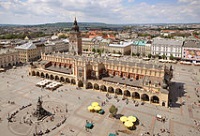
Main Market Square (Rynek Glówny)
Dating from 1257, the Central Market Square was one of the largest squares in medieval Europe and remains the social heart of Krakow. Surrounded by historic buildings, museums, and magnificent churches, the impressive expanse of flagstones is a hub of commercial and social activity. Flower sellers, ice-cream vendors, musicians, pigeons, students, and groups of tourists fill the square. The striking church of St Mary's is an impressive twin-spire Gothic structure while at the centre of the square is the splendid medieval Cloth Hall, its upstairs art gallery housing a collection of 19th-century Polish paintings and sculptures.
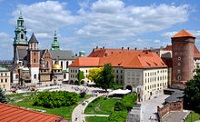
Wawel
Wawel is a hill overlooking Krakow, upon which stands an architectural complex that includes Wawel Castle and the Gothic Wawel Cathedral. It was here that all the Polish kings ruling between the 14th and the 17th centuries were crowned and buried, and it lies at the heart of Poland's royal history. The Renaissance-style castle is now a museum, with visitors able to see the Royal Private Apartments, Crown Treasury, Armoury, and the State Rooms. Of the many chapels in the cathedral, the golden-domed Chapel of King Sigismund is the finest. The bell tower can be climbed for views over the city and to see the enormous 11 tonne bell. A number of different guided tours are available so check the official website listed below for details.
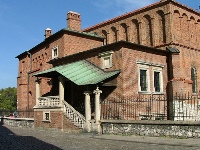
Kazimierz District and the Old Synagogue
The Kazimierz quarter was the centre of Jewish religion, culture, and learning before the Second World War. Badly damaged during the Nazi occupation, it has been rebuilt so visitors can admire the historical architecture and get an experience of what daily Jewish life was once like. The area is enlivened by art galleries, kosher restaurants, and numerous cultural events. The Oskar Schindler Factory Museum is itself a popular tourist attraction in Krakow, dedicated to the memory of Schindler and the Jewish workers he managed to save from the death camps. The Old Synagogue is part of the Historical Museum of Krakow, where the collection of physical memories from the Kazimierz Jewish community is kept.
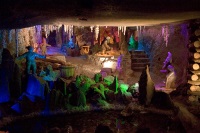
Wieliczka Salt Mine
A UNESCO World Cultural Heritage Monument, the Salt Mine at Wieliczka is a unique underground complex built in the Middle Ages. The series of labyrinthine tunnels, chambers, galleries, and underground lakes are spread over nine levels and reach a depth of more than 1,000ft (304m), but visitors are restricted to a tour of three levels. Centuries-old passageways contain huge crystalline caverns and carved chapels. The highlight is the Blessed Kinga Chapel where everything is carved from salt, dedicated to the patron saint of Polish mine workers. The world's first subterranean therapeutic sanatorium is situated 656ft (200m) below the surface, and makes use of the saline air for the treatment of asthma.
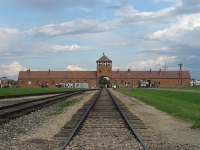
Auschwitz Memorial Museum
The Auschwitz concentration camp forms the largest cemetery in the world, preserved as a memorial to the victims of the Holocaust during the Second World War. Visitors can obvserve the structures, ruins, and gas chambers, while visiting exhibits at the museum. The buildings contain displays of photographs and piles of personal articles of the victims, including battered suitcases, and thousands of spectacles, hair, and shoes collected from the bodies. The sheer scale of the tragedy can be experienced at the Birkenau Camp, with a viewing platform to give some perspective over the vast fenced-in area. It was the principal camp where the extermination of millions took place, a chillingly efficient set-up with rows of barracks and four colossal gas chambers and ovens. Purpose-built railway tracks lead through the huge gateway along which victims were transported from the ghettos to the camp in crowded box-like carts. Taking a guided tour of the camps is the best way to fully comprehend what you are seeing and a tour takes at least three and a half hours. Visitors should try and book a place on one of the various guided tours at least two weeks before visiting - see the official website below for details.
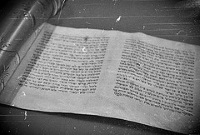
Galicia Jewish Museum
Situated in the heart of the Jewish Quarter of Krakow, the Galicia Jewish Museum houses a permanent photographic exhibition which is extremely powerful. It documents the history and heritage of the Jews in the villages and towns of Poland, focusing particularly on the Holocaust. Poland lost almost a quarter of its population in World War II, and the Jewish community was decimated. The museum has a bookshop, while also hosting plenty of temporary exhibitions, special events, lectures, and Jewish music concerts. The Galicia Jewish Museum is often overlooked as a tourist attraction in Krakow, but is a worthwhile experience for people from all walks of life. Budget at least three hours to fully absorb the experience. Guided tours are available and there is a charming little cafe for refreshments.
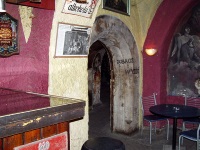
Piwnica pod Baranami
The Piwnica pod Baranami is a Parisian-style cabaret house located in Krakow's old town, allowing tourists to experience and appreciate the culture, values, and ideals of the city. Created by Piotr Skryznecki in 1956, this bohemian underground cellar soon became a haven for local artists and intellectuals where they would indulge in one of Poland's favourite cultural pastimes: political cabaret. The Piwnica pod Baranami still functions as a cabaret house to this day with performances on Saturdays at 9pm remaining extremely popular, so book your ticket early. A highly recommended tourist activity in Poland, it's a great spot to begin an unforgettable Saturday night.
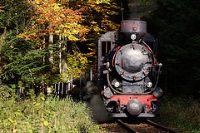
Bieszczady Mountains
While most tourists to Poland usually content themselves with the wonderful cultural experiences in the old towns of Warsaw and Krakow, a trip into the Polish countryside can be an equally rewarding enterprise. The Bieszczady Mountains run through the extreme southeast of Poland, near the Ukraine and Slovakia borders. A land of snow-capped peaks, tall pine trees, and vast green meadows, the Bieszczady region boasts hiking and mountain bike trails which wind through a rich array of native flora. Found in the UNESCO East Carpathian Biosphere Reserve, animal lovers should look out for lynxes, bears, and wolves.
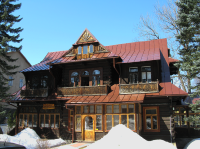
Zakopane
The Tatras is Poland's beautiful alpine range of towering peaks, rocky cliffs and glacial lakes, dotted with numerous little villages preserving a traditional highland lifestyle. The region's largest town is Zakopane, Poland's premier mountain resort. The winter sports capital of Poland, Zakopane is superbly situated at the foot of the Tatras with immediate access to the ski slopes in winter. The charming town has a laid-back fairytale atmosphere, the steep streets lined with traditional wooden cottages made from roughly cut logs and the 'Zakopane-style' architecture featuring delicately carved patterns and intricate woodwork decoration. The region is popular for outdoor activities and one of the more popular holiday attractions is the trip to the exquisite glacial lake, Morskie Oko.
Getting Around
Buses and trams are the easiest and cheapest way to get around in Krakow, though they can be crowded during rush hour. Tickets can be purchased at various kiosks, ticket machines and on the bus or tram itself. Taxis are readily available, though prices increase between 10pm and 8am. Radio taxis (identified by a taxi sign and the phone number of the company) usually offer the best rates and it is often cheaper to phone and order a taxi than to simply hail one down. As tourists are sometimes overcharged it is best to agree on a fare before getting into the taxi.
The Old Town is relatively compact and easy to negotiate, containing many of Krakow's tourist attractions: it is best explored on foot as most of it is designated a pedestrian-only area. Many of Krakow's attractions are within easy walking distance, and the public transport network is extensive so car hire is only really necessary if venturing outside the city. Car hire is easy in Krakow but Poland is not generally a country that provides a peaceful driving experience for foreigners as many of its highways are poorly maintained and the local drivers are somewhat unpredictable.
Krakow Climate and Weather
Krakow has a temperate climate, influenced by the weather systems that build over the Atlantic. The weather in Krakow in summer, between June and August, is comfortably warm with occasional heat waves when dry continental air comes in from the east. The average temperatures in summer range from 64°F to 67°F (18°C to 20°C), although temperatures can reach 86°F (30°C) during heat waves.
An old Polish poem says that in Krakow 'days are longest in June, hottest in July and most beautiful in August'. Autumn in Krakow, between September and November, brings dry, warm days starting with morning mist, and rich, golden colouration of the foliage. Winter is fairly severe and the city is often blanketed in snow, with temperatures dipping below freezing. The average temperatures in winter range from 28°F to 32°F (-2°C to 0°C) but can drop as low as 5°F (-15°C) on cold nights. Spring, between March and May, is arguably the best season in Krakow, when bright, mild days are accompanied by the fragrance of flower blossoms. Rain is most common in summer but can fall at any time of year.
Summer is the peak tourist season in Krakow, but to avoid the crowds it is best to visit the city in spring or early autumn, when the weather is mild and pleasant and there is less chance of rain.
Poland travel info
Electricity
Electrical current is 230 volts, 50Hz. The standard two-pin European style plugs are used.
Language
The national language is Polish; however, English is widely understood in tourist areas.
Money
The official currency is the Polish zloty (PLN), divided into 100 groszy. Poland still uses cash more frequently than visitors might expect, while ATMs (bankomats) and credit card facilities are available in major towns and cities. Money can be exchanged in the cities and larger towns at banks, hotels or bureaux de change called kantors, which offer the best rates. Banks are open Monday to Friday from 10am to 6pm, and some are open on Saturday until 1pm.
Tipping
Tipping is expected in restaurants in Poland and 15 percent is the standard for good service. In restaurants, when your bill is collected, saying 'thank you' signals to the waiter/waitress that they can keep the change. Tipping is not the norm in hotels across Poland, but taxis, tours and spas generally expect no less than 10 percent tip for good service.
Health
There are few health risks associated with travel to Poland. After Brexit, the Global Health Insurance Card (GHIC) replaced the European Health Insurance Card (EHIC) for UK citizens. The GHIC allows UK citizens access to state healthcare during visits to the EU. The GHIC is not valid in Norway, Iceland, Liechtenstein or Switzerland, nor is it an alternative to travel insurance. Medical facilities and standards of healthcare are good, but not many nurses or doctors speak English. If travellers take prescription medication along, they should be sure to bring a signed and dated letter from a doctor detailing what it is and why it is needed.
Safety
Having said that, visits to Poland are usually trouble free, and the precautions travellers should take are merely the safety measures advised for cities all over the world.
Local customs
Family is incredibly important in Polish society, with many citizens relying heavily on their close-knit inner circles which also may include close friends. Parties can be formal, so don't be surprised if you're introduced by your host and try to use the prefix 'Pan' for males and 'Pani' for females when addressing others. It serves as the Polish equivalent for 'Mr' and 'Ms'.
Doing business
Poland has an interesting mix of the old and the new, and this is apparent in the business world too. Women can expect a kiss on the hand rather than a handshake from the older generation and one can expect to be warmly offered drinks during meetings; it is impolite to refuse. Although the Polish are hospitable and friendly, business is still conducted formally. Punctuality is important, dress should be formal and conservative (a suit and tie are the norm) and business cards are exchanged. Use titles and last names unless otherwise indicated. English is widely spoken, though attempting some basic Polish phrases will be appreciated. Business hours in Poland are traditionally 8am to 4pm Monday to Friday, and lunch breaks are not a given as they are often unpaid.
Duty free
Travellers to Poland over 17 years, arriving from non-EU countries, do not have to pay duty on 250 cigarettes or 50 cigars or 250g tobacco; 1 litre wine and 1 litre spirits; cosmetics and medicines for personal use; gifts up to the value of €430. Travellers to Poland arriving from within the EU do not have to pay duty on 800 cigarettes or 200 cigars or 1kg smoking tobacco; 10 litres spirits, 90 litres wine and 110 litres beer. Prohibited items include birds and poultry arriving from countries infected with avian influenza. The export of all articles of artistic, historic or cultural value are subject to special regulations.
Communications
The international access code for Poland is +48 and wifi is available in towns and cities.
Passport & Visa
A passport valid for at least three months after period of intended stay is needed for those who require a visa. Generally, visa exempt nationals must have a passport valid for period of intended stay (other than EEA nationals). The borderless region known as the Schengen area includes the following countries: Austria, Belgium, Czech Republic, Denmark, Estonia, Finland, France, Germany, Greece, Hungary, Iceland, Italy, Latvia, Liechtenstein, Lithuania, Luxembourg, Malta, The Netherlands, Norway, Poland, Portugal, Slovakia, Slovenia, Spain, Sweden and Switzerland. All these countries issue a standard Schengen visa that has a multiple entry option that allows the holder to travel freely within the borders of all.
Entry requirements
US nationals do not require a visa for stays of up to 90 days within a 180-day period. Passports must be valid for three months beyond period of intended stay.
UK nationals do not require a visa for stays of up to 90 days within a 180-day period. Passports must be valid for three months beyond period of intended stay.
Canadian nationals do not require a visa for stays of up to 90 days within a 180-day period. Passports must be valid for three months beyond period of intended stay.
Australians require a passport valid for at least three months beyond period of intended stay. No visa is required for stays of up to 90 days within a 180-day period.
South African passport holders require a visa for travel to Poland. Passports must be valid for at least three months beyond period of intended stay.
Irish nationals require a passport valid on arrival, but no visa is necessary.
New Zealand nationals require a passport valid for at least three months beyond the period of intended stay. A visa is not needed for up to 90 days within a 180-day period.
Useful contacts
Polish National Tourist Office, Warsaw: +48 (0)22 536 7070 or www.pot.gov.pl.
112 (Fire Department, Ambulance and Police).Embassies / consulates in other countries
Polish Embassy, Washington DC, United States: +1 202 499 1700.
Polish Embassy, London, United Kingdom: +44 20 7291 3520.
Polish Embassy, Ottawa, Canada: +1 613 789 0468.
Polish Embassy, Sydney, Australia: +61 2 6272 1000.
Polish Embassy, Pretoria, South Africa: +27 12 430 2632.
Polish Embassy, Dublin, Ireland: +353 1 283 0855.
Polish Embassy, Wellington, New Zealand: +64 4 499 7844.
Embassies / consulates in Poland
United States Embassy, Warsaw: +48 22 504 2000.
British Embassy, Warsaw: +48 22 311 0000.
Canadian Embassy, Warsaw: +48 22 584 3100.
Australian Embassy, Warsaw: +48 22 521 3444.
South African Embassy, Warsaw: +48 22 622 1031.
Irish Embassy, Warsaw: +48 22 564 2200.
New Zealand Embassy, Warsaw: +48 22 521 0500.



